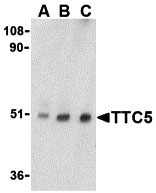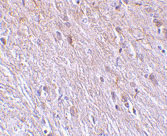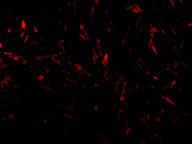TTC5 Antibody
- SPECIFICATION
- CITATIONS
- PROTOCOLS
- BACKGROUND

Application
| WB, IHC-P, IF, E |
|---|---|
| Primary Accession | Q8N0Z6 |
| Other Accession | Q8N0Z6, 67462006 |
| Reactivity | Human, Mouse |
| Host | Rabbit |
| Clonality | Polyclonal |
| Isotype | IgG |
| Calculated MW | 48928 Da |
| Application Notes | TTC5 antibody can be used for the detection of TTC5 by Western blot at 0.5 - 2 µg/mL. Antibody can also be used for immunohistochemistry starting at 10 µg/mL. For immunofluorescence start at 20 µg/mL. |
| Gene ID | 91875 |
|---|---|
| Other Names | TTC5 Antibody: Strap, Tetratricopeptide repeat protein 5, Stress-responsive activator of p300, TPR repeat protein 5, tetratricopeptide repeat domain 5 |
| Target/Specificity | TTC5; |
| Reconstitution & Storage | TTC5 antibody can be stored at 4℃ for three months and -20℃, stable for up to one year. As with all antibodies care should be taken to avoid repeated freeze thaw cycles. Antibodies should not be exposed to prolonged high temperatures. |
| Precautions | TTC5 Antibody is for research use only and not for use in diagnostic or therapeutic procedures. |
| Name | TTC5 (HGNC:19274) |
|---|---|
| Function | Cofactor involved in the regulation of various cellular mechanisms such as actin regulation, autophagy, chromatin regulation and DNA repair (PubMed:18451878, PubMed:31727855). In non-stress conditions, interacts with cofactor JMY in the cytoplasm which prevents JMY's actin nucleation activity and ability to activate the Arp2/3 complex. Acts as a negative regulator of nutrient stress-induced autophagy by preventing JMY's interaction with MAP1LC3B, thereby preventing autophagosome formation (By similarity). Involves in tubulin autoregulation by promoting its degradation in response to excess soluble tubulin (PubMed:31727855). To do so, associates with the active ribosome near the ribosome exit tunnel and with nascent tubulin polypeptides early during their translation, triggering tubulin mRNA- targeted degradation (PubMed:31727855). Following DNA damage, phosphorylated by DNA damage responsive protein kinases ATM and CHEK2, leading to its nuclear accumulation and stability. Nuclear TTC5/STRAP promotes the assembly of a stress-responsive p53/TP53 coactivator complex, which includes the coactivators JMY and p300, thereby increasing p53/TP53-dependent transcription and apoptosis. Also recruits arginine methyltransferase PRMT5 to p53/TP53 when DNA is damaged, allowing PRMT5 to methylate p53/TP53. In DNA stress conditions, also prevents p53/TP53 degradation by E3 ubiquitin ligase MDM2 (By similarity). Upon heat-shock stress, forms a chromatin- associated complex with heat-shock factor 1 HSF1 and p300/EP300 to stimulate heat-shock-responsive transcription, thereby increasing cell survival (PubMed:18451878). Mitochondrial TTC5/STRAP interacts with ATP synthase subunit beta ATP5F1B which decreased ATP synthase activity and lowers mitochondrial ATP production, thereby regulating cellular respiration and mitochondrial-dependent apoptosis. Mitochondrial TTC5/STRAP also regulates p53/TP53-mediated apoptosis (By similarity). |
| Cellular Location | Nucleus {ECO:0000250|UniProtKB:Q99LG4}. Cytoplasm. Cytoplasmic vesicle {ECO:0000250|UniProtKB:Q99LG4}. Mitochondrion matrix {ECO:0000250|UniProtKB:Q99LG4}. Note=Phosphorylation at Ser-203 results in nuclear localization, while unphosphorylated protein localizes to the cytoplasm. Nuclear localization may be necessary for DNA damage- dependent stabilization of the protein. {ECO:0000250|UniProtKB:Q99LG4} |

Thousands of laboratories across the world have published research that depended on the performance of antibodies from Abcepta to advance their research. Check out links to articles that cite our products in major peer-reviewed journals, organized by research category.
info@abcepta.com, and receive a free "I Love Antibodies" mug.
Provided below are standard protocols that you may find useful for product applications.
Background
TTC5 Antibody: Tetratricopeptide repeat protein 5 (TTC5) is a member of a diverse group of functionally distinct proteins that are characterized by containing one or more tetratricopeptide repeats. Each motif consists of two anti-parallel a-helices such that tandem arrays of TPR motifs generate a right-handed helical structure with an amphipathic channel that may serve to accommodate the complementary region of a target protein. While the exact function of TTC5 remains unclear, it is thought that the TPR motifs serve to mediate protein-protein interactions such as those seen with protein chaperones HSP70 and HSP90 and some proteins involved in cell stress response signaling pathways such as protein phosphatase 5, suggesting that TTC5 may also function via protein-protein interactions mediated by its TPR motifs.
References
Blatch GL and Lassle M. The tetratricopeptide repeat: a structural motif mediating protein-protein interactions. BioEssays 1999; 21:932-9
Song Y and Masison DC. Independent regulation of Hsp70 and Hsp90 chaperones by Hsp70/Hsp90-organizing protein Sti1 (Hop1). J. Biol. Chem. 2005; 280:34178-85.
Yang J, Roe SM, Cliff MJ, et al. Molecular basis for TPR domain-mediated regulation of protein phosphatase 5. EMBO J. 2005; 24:1-10.
If you have used an Abcepta product and would like to share how it has performed, please click on the "Submit Review" button and provide the requested information. Our staff will examine and post your review and contact you if needed.
If you have any additional inquiries please email technical services at tech@abcepta.com.













 Foundational characteristics of cancer include proliferation, angiogenesis, migration, evasion of apoptosis, and cellular immortality. Find key markers for these cellular processes and antibodies to detect them.
Foundational characteristics of cancer include proliferation, angiogenesis, migration, evasion of apoptosis, and cellular immortality. Find key markers for these cellular processes and antibodies to detect them. The SUMOplot™ Analysis Program predicts and scores sumoylation sites in your protein. SUMOylation is a post-translational modification involved in various cellular processes, such as nuclear-cytosolic transport, transcriptional regulation, apoptosis, protein stability, response to stress, and progression through the cell cycle.
The SUMOplot™ Analysis Program predicts and scores sumoylation sites in your protein. SUMOylation is a post-translational modification involved in various cellular processes, such as nuclear-cytosolic transport, transcriptional regulation, apoptosis, protein stability, response to stress, and progression through the cell cycle. The Autophagy Receptor Motif Plotter predicts and scores autophagy receptor binding sites in your protein. Identifying proteins connected to this pathway is critical to understanding the role of autophagy in physiological as well as pathological processes such as development, differentiation, neurodegenerative diseases, stress, infection, and cancer.
The Autophagy Receptor Motif Plotter predicts and scores autophagy receptor binding sites in your protein. Identifying proteins connected to this pathway is critical to understanding the role of autophagy in physiological as well as pathological processes such as development, differentiation, neurodegenerative diseases, stress, infection, and cancer.




